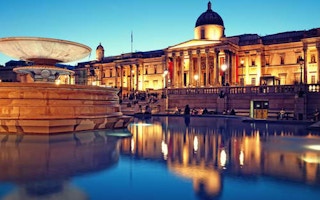Greek scientists have identified a new way to measure air pollution during the last 500 years. They matched paintings of sunsets with a calendar of 50 famous volcanic eruptions recorded between 1500 and 2000.
And they found that successive artists had faithfully if unconsciously recorded the changing colours of the sky as volcanic dust and aerosols scattered light and made the sunsets even more red.
Christos Zerefos of the Academy of Athens, with eight Greek colleagues and one German co-author, analysed hundreds of high quality digital copies of the world’s masterpieces to find a general colour rule that seemed to hold, independently of the artist’s style, school or date.
The ratio of red to green in each painting could tell a story of clear or scattered light, and therefore perhaps reveal a sunset made more lurid by the dust of an eruption.
“Nature speaks to the hearts and souls of great artists,” said Professor Zerefos. “But we found that, when colouring sunsets, it is the way their brains perceive greens and reds that contains important environmental information.”
The connection with climate change is real: powerful volcanic eruptions eject huge quantities of ash or aerosols into the upper atmosphere and lower the temperature. That is, they can alter the climate.
“
We wanted to provide alternative ways of exploiting the environmental information in the past atmosphere in places where, and in centuries when, instrumental measurements were not available
Professor Christos Zerefos, Academy of Athens
Sunset paintings
Modern climate researchers long ago identified the lurid sunsets of JMW Turner and the white Christmases celebrated by Charles Dickens as indirect testimony to the impact of the eruption of Mount Tambora in 1815, which created the so-called “year without a summer” in Europe in 1816, in which an estimated 60,000 people died of starvation and disease.
In 2003 the Texan astronomer Donald Olson linked the lurid skies of the famous painting The Scream, by the Norwegian Edvard Munch, with the eruption of Krakatoa in 1883.
But Zerefos and his colleagues report in the journal Atmospheric Chemistry and Physics that they went further. They counted the eruptions of the last 500 years, and scored the subsequent three years of each as “volcanic”.
Then they went looking for paintings that were unmistakably sunset studies, with the sun at the appropriate zenith angle. They settled on 124 high quality digital images from the Tate Gallery in London, to arrive at a measure of what they called “aerosol optical depth” or AOD at the 550 nanometre wavelength of light.
Double check
They also examined 186 landscape paintings from the National Gallery in London as a check on their first findings. They found that not only was their aerosol optical depth measure detectable in paintings coincident with a major eruption; there was a steady perceptible increase in aerosol optical depth after the start of the Industrial Revolution, when air pollution became a fact of city life.
And then, just to make sure, they asked a master colourist on the Greek island of Hydra to paint a succession of sunsets before, during and after a Saharan dust storm passed overhead in 2010. The painter’s changing red/green ratios were consistent with their hypothesis.
“Because of the large number of paintings studied, we tentatively propose the conclusion that regardless of school, red-to-green ratios from great masters can provide independent proxy AODs that correlate with widely accepted proxies and with independent measurements,” they write in the study.
In effect, they now have another way of identifying climate change in the past. Zerefos adds: “We wanted to provide alternative ways of exploiting the environmental information in the past atmosphere in places where, and in centuries when, instrumental measurements were not available.”

















